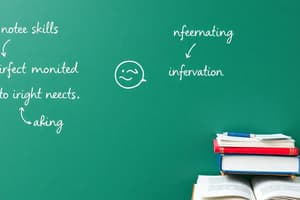Podcast
Questions and Answers
What is the primary goal of note-taking?
What is the primary goal of note-taking?
- To express personal opinions
- To highlight every detail in the text
- To create an exhaustive report
- To summarize key concepts clearly (correct)
Which method is recommended to organize information in notes?
Which method is recommended to organize information in notes?
- Writing in full sentences exclusively
- Employing bullet points or numbered lists (correct)
- Highlighting every single word
- Using lengthy paragraphs
How should each bullet point in notes be constructed?
How should each bullet point in notes be constructed?
- A complete thought that stands alone (correct)
- An incomplete thought that requires context
- A detailed description of a concept
- A personal interpretation of the text
What approach should one take while reading the material to take effective notes?
What approach should one take while reading the material to take effective notes?
What should be avoided while taking notes according to the guidelines?
What should be avoided while taking notes according to the guidelines?
Flashcards
Effective note-taking
Effective note-taking
Concise, clear notes focusing on key concepts, organized logically, using bullet points and subheadings.
Note-taking structure
Note-taking structure
Logical organization of notes using bullet points and subheadings to make review easy and comprehension efficient.
Active reading for notes
Active reading for notes
Engaging with the material while reading, identifying main ideas, paraphrasing and summarizing important information, and organizing logically.
Note-taking conciseness
Note-taking conciseness
Signup and view all the flashcards
Objective note-taking
Objective note-taking
Signup and view all the flashcards
Study Notes
General Instructions for Note-Taking
- Conciseness is key. Avoid unnecessary detail. Summarize key concepts and facts, avoiding lengthy descriptions.
- Focus on clarity and brevity. The goal is to create easy-to-review notes, not exhaustive reports.
- Use bullet points or numbered lists where appropriate to organize information.
- Maintain an objective and factual tone. Avoid personal opinions or interpretations.
- Use markdown for formatting, limiting use of headers to ### and below. Subheadings are acceptable to organize ideas if helpful.
- Each bullet point should be a complete thought, easily understood independently.
Note-Taking Format
- Note-taking should be structured for easy review and efficient understanding.
- Bullet points are ideal for listing essential information.
- Use sub-headings to categorize related information in a logical manner.
- Maintain factual accuracy. Avoid adding personal commentary or inferences.
- Focus on extracting the main points and key concepts from the input material.
Note-Taking Process
- Active reading is essential. Engage with the material while reading. Do not passively scan.
- Identify key concepts and main ideas. Underline, highlight, or annotate the text with these important points.
- Paraphrase and summarize the key information in your own words. This helps with retention and understanding.
- Organize information logically using headings and sub-headings where appropriate.
- Ensure the format is clear and easy to read, with distinct and concise summaries.
- Use bullet points to list important information; these are ideal for organization and concise summaries.
- Each bullet should stand alone and carry meaning without dependence on other bullets.
- Aim for completeness while maintaining conciseness.
Studying That Suits You
Use AI to generate personalized quizzes and flashcards to suit your learning preferences.




